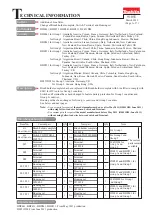
11.0 LOW VOLTAGE DISCONNECT
The LVD function operates simply:
o
When the battery voltage falls to 11.9 (23.8) Volts, the load is disconnected. This value of voltage
is very conservative, but it is also based on the fact that typical applications have large batteries
and light loads… loads in the area of C/100 tend to be typical. Popular thought suggests that a
lower value of voltage could be used… perhaps 11.5 Volts. This arises from published data
based on testing from more heavily loaded batteries… C/20. In the case of a sealed lead-acid
battery, a lightly loaded battery at 11.8 Volts is truly dead… 0% SOC. So… changes in LVD set
point should be made very cautiously. The purpose of the LVD is prevent battery damage. The
temptation on the part of designers and users, to avoid battery capacity or extend hold-up time, is
to lower the set-point to a value that defeats its purpose. Obviously, this is not advisable.
o
When the battery voltage rises to 13.1 (26.2) Volts, the load is reconnected. This value of voltage
ensures that load cycling or oscillation will not occur once an LVD has been triggered. This also
ensures that the battery is given the full output of the DC-UPS to recharge before resuming
supply to the load. A value of 13.1 Volts corresponds VERY roughly to a SOC of 50-80%... a
safe point to resume the load and thereby divert some available charge current to the load.
o
The logic employs filtering so that transients lasting less than a second or so are ignored. This is
a simple RC filter, so the magnitude of the transient affects the time period. This avoids
“nuisance tripping” of the disconnect.
•
Both of the LVD set-points are temperature compensation in the same way as the charge voltage.
Because the “float charge” voltage and the “resting voltage“ of a battery do not exactly track, especially at
low temperatures, the use of the LVD in function in low temperatures, less than 10 C, may cause
problems. Specifically, the LVD may disconnect prematurely, leaving usable battery capacity unavailable.
This is a function of battery chemistry. For systems operating below 10 C, testing should be performed to
establish proper implementation. Again, careful consideration should be paid to the use of the LVD… at
temperatures of -10 C and below… the LVD function is counter-productive.
































